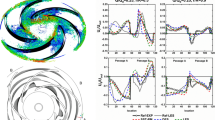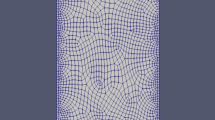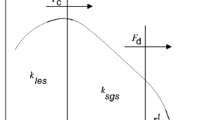Abstract
This research focuses on the development of wall functions suitable for the prediction of high-speed compressible flows, using RANS-based models. Wall-functions avoid the need for expensive fine near-wall meshes. The conventional log-law-based wall functions, however, have limitations even in incompressible cases, which are further compounded when applied to high-speed compressible flows. The analytical wall function proposed by Craft (Int. J. Heat Fluid Flow 23:148-160, 2002), which involves the analytical solution of simplified boundary-layer forms of the transport equations for the mean flow variables over the near-wall control volumes, has been successfully used in a range of incompressible flows. In this paper, a compressible flow version of the analytical wall function is proposed, which includes the following modifications: (a) improved variation of the convection terms in boundary-layer forms of the mean flow transport equations over the near-wall cells, (b) inclusion of thermal dissipation terms in the simplified analytical equation for the energy variation over the near-wall cells, (c) a more realistic representation of the thermal dissipation process in the discretized energy equation over the near-wall cells, (d) variable molecular viscosity (due to temperature variations) over the viscous sub-layer. The resultant model has been applied to shock wave/turbulent boundary layer interactions up to Mach numbers of 9 and comparisons are drawn with experimental data and with predictions from the log-law-based wall functions and from the Low-Re Launder and Sharma \(k-\varepsilon\) model. The predictions resulting from the use of the compressible version of the analytical wall function are consistently closer to the data than those of other wall functions, and in some instances even better than those of corresponding low-Reynolds-number models. Improvements are especially noticeable in the prediction of the wall heat flux rates, where, in the highest Mach number cases, the log-law wall function generally predicts too low values in the shock interaction region, while the low-Reynolds-number models predict too high heat transfer rates, as a result of over-predicting turbulence levels in regions of extremely rapid near-wall temperature variations.






















Similar content being viewed by others
References
Adams, N.A.: Direct simulation of the turbulent boundary layer along a compression ramp at M=3 and \(\text{ Re}_\theta\)= 1685. J. Fluid Mech. 420, 47–83 (2000)
Chieng, C.C., Launder, B.E.: On the calculation of turbulent heat transport downstream from an abrupt pipe expansion. Numer. Heat Transf. 3(2), 189–207 (1980)
Coakley, T.J., Horstman, C.C., Marvin, J.G., Viegas, J.R., Bardina, J.E., Huang, P.G., Kussoy, M.I.: Turbulence compressibility corrections. NASA TM 108827, 1–30 (1994)
Coleman, G.T., Stollery, J.L.: Heat transfer from hypersonic turbulent flow at a wedge compression corner. J. Fluid Mech. 56(4), 741–752 (1972)
Craft, T.J., Launder, B.E., Suga, K.: Development and application of a cubic Eddy-viscosity model of turbulence. Int. J. Heat Fluid Flow 17(2), 108–115 (1996)
Craft, T.J., Iacovides, H., Yoon, J.H.: Progress in the use of non-linear two-equation models in the computation of convective heat-transfer in impinging and separated flows. Flow Turbul. Combust. 63(1–4), 59–80 (2000)
Craft, T.J., Gerasimov, A.V., Iacovides, H., Launder, B.E.: Progress in the generalization of wall-function treatments. Int. J. Heat Fluid Flow 23(2), 148–160 (2002)
Craft, T.J., Gerasimov, A.V., Iacovides, H., Kidger, J.W., Launder, B.E.: The negatively buoyant turbulent wall jet: performance of alternative options in RANS modelling. Int. J. Heat Fluid Flow 25(5), 809–823 (2004)
Craft, T.J., Gant, S.E., Gerasimov, A.V., Iacovides, H., Launder, B.E.: Development and application of wall-function treatments for turbulent forced and mixed convection flows. Fluid Dyn. Res. 38(2–3), 127–144 (2006)
Craft, T.J., Iacovides, H., Mostafa, N.A.: Modelling of three-dimensional jet array impingement and heat transfer on a concave surface. Int. J. Heat Fluid Flow 29(3), 687–702 (2008)
Craft, T.J., Iacovides, H., Launder, B.E., Zacharos, A.: Some swirling-flow challenges for turbulent CFD. Flow Turbul. Combust. 80(4), 419–434 (2008)
Craft, T.J., Iacovides, H., Omranian, A.: The computation of buoyant flows in differentially heated inclined cavities. Int. J. Heat Mass Transf. 77, 1–16 (2014)
Délery, J., Marvin, J.G., and Reshotko, E.: Shock-wave boundary layer interactions. Report No. ADA171302. Advisory Group for Aerospace Research and Development (1986)
Dolling, D.S.: Fifty years of shock-wave/boundary-layer interaction research: what next? AIAA J. 39(8), 1517–1531 (2001)
Favre, A.: Equations des gaz turbulents compressibles. J. de Mec., 4(3) (1965)
Fernholz, H.H., Dussauge, J.P., Finlay, P.J., Smits, A.J., Reshotko, E.: A survey of measurements and measuring techniques in rapidly distorted compressible turbulent boundary layers. AGARD, 315 (1989)
Georgiadis, N.J., Rumsey, C.L.: Revisiting turbulence model validation for high-mach number axisymmetric compression corner flows. In: 53rd AIAA Aerosp. Sci. Meet., January (2015)
Gerasimov, A.V.: Development and validation of an analytical wall-function strategy for modelling forced, mixed and natural convection flows. Doctoral dissertation, University of Manchester (2004)
Green, J.E.: Reflexion of an oblique shock wave by a turbulent boundary layer. J. Fluid Mech. 40(1), 81–95 (1970)
Greenshields, C.J., Weller, H.G., Gasparini, L., Reese, J.M.: Implementation of semi-discrete, non-staggered central schemes in a colocated, polyhedral, finite volume framework, for high-speed viscous flows. Int. J. Numer. Methods. Fluids 63(1), 1–21 (2010)
Huang, P.G., Bradshaw, P., Coakley, T.J.: Turbulence models for compressible boundary-layers. AIAA J. 32(4), 735–740 (1994)
Jayatilleke, C.L.V.: The influence of Prandtl number and surface roughness on the resistance of the laminar sub-layer to momentum and heat transfer. Doctoral dissertation, University of London (1966)
Katsamis, C., Craft, T., Iacovides, H., Uribe, J.: Use of 2-D and 3-D unsteady RANS in the computation of wall bounded buoyant flows. Int. J. Heat Fluid Flow 93, 108914 (2022)
Knight, D., Yan, H., Panaras, A.G., Zheltovodov, A.: Advances in CFD prediction of shock wave turbulent boundary layer interactions. Prog. Aerosp. Sci. 39(2–3), 121–184 (2003)
Kuntz, D.W., Amatucci, V.A., Addy, A.L.: Turbulent boundary-layer properties downstream of the shock-wave/boundary-layer interaction. AIAA J. 25(5), 668–675 (1987)
Kussoy, M.I., Horstman, K.C.: Documentation of two- and three-dimensional shock-wave/turbulent-boundary-layer interaction flows at Mach 8.2. NASA Ames Research Center Technical Report, 1–46 (1991)
Kussoy, M.I., Horstman, C.C.: Documentation of two-and three-dimensional hypersonic shock wave/turbulent boundary layer interaction flows. NASA Ames Research Center Technical Report (1989)
Kussoy, M.I., Horstmann, C.C.: An experimental documentation of a hypersonic shock-wave turbulent boundary layer interaction flow: with and without separation. NASA STI/Recon Tech. Rep. N 75, 21554 (1975)
Launder, B.E., Sharma, B.I.: Application of the energy-dissipation model of turbulence to the calculation of flow near a spinning disc. Lett. Heat Mass Transf. 1, 131–137 (1974)
Launder, B.E., Spalding, D.B.: The numerical computation of turbulent flows. Comput. Methods Appl. Mech. Eng. 3(2), 269–289 (1974)
Patankar, S.: Numerical Heat Transfer and Fluid Flow. CRC Press, London (1980)
Reda, D.C., Murphy, J.D.: Shock wave/turbulent boundary-layer interactions in rectangular channels. AIAA J. 11(2), 139–140 (1973)
Roe, P.L., Pike, J.: Efficient construction and utilisation of approximate Riemann solution. Comput. Appl. Sci. Eng., 95–103 (1984)
Roy, C.J., Blottner, F.G.: Review and assessment of turbulence models for hypersonic flows. Prog. Aerosp. Sci. 42(7–8), 469–530 (2006)
Rubesin, M.W.: Extra compressibility terms for favre-averaged two-equation models of inhomogeneous turbulent flows. NASA CR 177556 (1990)
Schülein, E: Optical skin friction measurements in short-duration facilities. In: 24th AIAA Aerodynamic Measurement Technology and Ground Testing Conference, 1–18 (2004)
Schülein, E., Krogmann, P., Stanewsky,E.: Documentation of two-dimensional impinging shock/turbulent boundary layer interaction flow. DLR Report DLR IB 223-96 A 49 (1996)
Settles, G., Dodson, L.: Hypersonic shock/boundary-layer interaction database. In: 22nd Fluid Dynamics, Plasma Dynamics and Lasers Conference. American Institute of Aeronautics and Astronautics, Reston, Virigina (1991)
Settles, G.S., Dodson, L.J.: Supersonic and hypersonic shock/boundary-layer interaction database. AIAA J. 32(7), 1377–1383 (1994)
Settles, G.S., Fitzpatrick, T.J., Bogdonoff, S.M.: Detailed study of attached and separated compression corner flowfields in high Reynolds number supersonic flow. AIAA J. 17(6), 579–585 (1979)
Smits, A.J., Muck, K.C.: Experimental study of three shock wave/turbulent boundary layer interactions. J. Fluid Mech. 182, 291–314 (1987)
Sutherland, W.: The viscosity of gases and molecular force. Lond., Edinb., Dublin Philos. Mag. J. Sci. 36(223), 507–531 (1893)
Trettel, A., Larsson, J.: Mean velocity scaling for compressible wall turbulence with heat transfer. Phys. Fluids 28, 026102 (2016)
Van Albada, G.D., Van Leer, B., Roberts, W.: A Comparative Study of Computational Methods in Cosmic Gas Dynamics. In: Upwind and High-Resolution Schemes, pp. 95–103. Springer, Berlin, Heidelberg (1997)
Vuong, S.T., Coakley, T.J.: Modeling of turbulence for hypersonic, flows with and without separation. In: 25th AIAA Aerospace Sciences Meeting, AIAA Paper 1987-0286 (1987)
Wang, Xinguang: Advanced RANS and Near-Wall Turbulence Modelling for High-Speed Flow. Doctoral dissertation, University of Manchester (2018)
Yap, C.R.: Turbulent heat and momentum transfer in recirculating and impinging flows. Doctoral dissertation, University of Manchester (1987)
Zhang, H., Craft, T., Iacovides, H.: The application of linear and non-linear two-equation turbulence models in hypersonic flows. AIAA J. 60, 1–15 (2022)
Acknowledgements
The authors gratefully acknowledge the support from the National Natural Science Foundation of China (Grant No. 11972362) and National Numerical Windtunnel project of China for this study.
Funding
The authors gratefully acknowledge the support from the National Natural Science Foundation of China (Grant No. 11972362).
Author information
Authors and Affiliations
Corresponding author
Ethics declarations
Conflict of interest
The authors declare that they have no conflicts of interest.
Appendix
Appendix
1.1 a. Hydrodynamic Analytical Wall Function
In all subsequent equations, subscript “1” denotes the zero-turbulent viscosity sublayer (\(y^*<y^*_v\)), and subscript “2” the turbulent region of the turbulent layer (\(y^*>y^*_v\)).
The second integration of Eq. (18) with hyperbolic variation for the molecular viscosity over the zero turbulent viscosity sub-layer gives:
From the near wall cell boundary conditions, the coefficients in the above equations are:
The coefficient N in (34) represents
where
1.2 b. Thermal Analytical Wall Function
In the zero-turbulent viscosity sublayer (\(y^*<y^*_v\)), the second integration of Eq. (22) with hyperbolic variation gives:
In the turbulent layer (\(y^*>y^*_v\)), the analytical temperature is:
where the coefficients in the above equations are
In order to complete the thermal wall function, the final expression for the wall temperature needs to be substituted into the code for prescribed heat-flux boundary conditions. From Eq. (39), when \({y^ * } = y_n^ *\), and \(T_2=T_n\):
For the isothermal wall boundary conditions:
where \(A_{th1}\) can be obtained from (42) as:
where
Rights and permissions
Springer Nature or its licensor (e.g. a society or other partner) holds exclusive rights to this article under a publishing agreement with the author(s) or other rightsholder(s); author self-archiving of the accepted manuscript version of this article is solely governed by the terms of such publishing agreement and applicable law.
About this article
Cite this article
Wang, X., Chen, J., Craft, T. et al. Extension of Analytical Wall Functions to Supersonic and Hypersonic Flows. Flow Turbulence Combust 111, 1–34 (2023). https://doi.org/10.1007/s10494-023-00412-7
Received:
Accepted:
Published:
Issue Date:
DOI: https://doi.org/10.1007/s10494-023-00412-7




